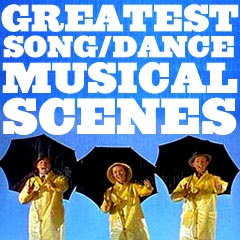
|
|
| D | ||
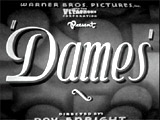
|
Dames (1934) This film followed up on The Gold Diggers of 1933 (1933) with more astonishing Busby Berkeley production numbers, including the clever and most memorable I Only Have Eyes For You (pictured) (sung by Dick Powell), in which Ruby Keeler and Powell fell asleep aboard a subway train. During the dream, he saw repeated images of her face (actually chorus girls with large Keeler-face masks) and images of white-gowned chorus girls on a rotating white ferris wheel and multiple sets of stairs - the set ended with the chorus girls (with puzzle pieces strapped on their backs) coming together to form a huge jigsaw puzzle of Ruby's face In the title number finale Dames (pictured), close-ups of the faces of various 'dames' applying for work led to the camera voyeuristically following the chorus girls with white blouses (and black tights) through a single day (including their waking, stretching, bathing in a bubble bath, powdering, applying makeup, etc.). Everything ended with an overhead kaleidoscopic star-formation of abstract designs - and one sequence where the trick reverse-action camera made it appear that the tap-dancing chorines were flying straight up from the floor into the camera. |
 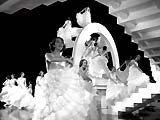   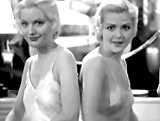 
|
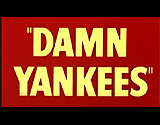
|
Damn Yankees (1958) This Faustian musical baseball fantasy from Warner Brothers was co-directed by George Abbott and Stanley Donen and featured choreography supervised by Bob Fosse. This adaptation of the Broadway hit was about a sensational Washington Senators baseball player Joe Hardy (Tab Hunter) who was under the spell of the Devil-Mr. Applegate (Ray Walston) and the Devil's sizzlingly seductive and tempting assistant Lola (Gwen Verdon) to convince Joe to stay young and not convert to his old self. Verdon's sensuous, hot-blooded show-stopping Whatever Lola Wants (Lola Gets) (pictured) performed in the locker room with Joe was the highlight of the film. Other numbers included:
Also memorable was the stage song/dance duet between Fosse (as a Mambo dancer) and Verdon called Who's Got the Pain (pictured). |
 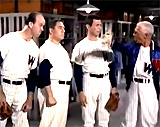 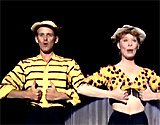
|
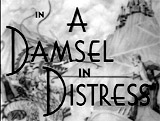
|
A Damsel in Distress (1937) Fred Astaire's first film without Ginger Rogers was this one - with a Gershwin score and leading lady Joan Fontaine (as Lady Alyce Marshmorton). Two of Astaire's (as American dancer Jerry Halliday living in London) most notable numbers were:
He also performed a romping number (an Oscar-winner for Best Dance Direction by Hermes Pan) titled Stiff Upper Lip (pictured) with the comedy team of George Burns and Gracie Allen in an English fair funhouse filled with spinning discs, barrels, and distorted mirrors. |
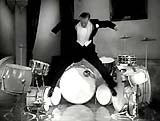 
|
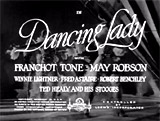
|
Dancing Lady (1933) This whole production was an imitation of the year's other backstage musical 42nd Street (1933). In his first screen appearance, Fred Astaire (already wearing his trademark top hat and tails) danced opposite MGM star Joan Crawford (as upwardly aspiring dancer Janie Barlow) in this musical extravaganza in the number Heigh, Ho, The Gang's All Here (pictured). |

|
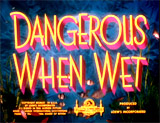
|
Dangerous When Wet (1953) In this musical film, aqua-queen Esther Williams (as English Channel swimmer Katie Higgins) performed her famous underwater ballet with MGM cartoon stars Tom and Jerry, reprising the Arthur Schwartz and Johnny Mercer tune In My Wildest Dreams (pictured). |

|
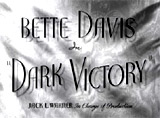
|
At a nightclub-bar at closing time, drunken socialite Judith Traherne (Bette Davis) demanded that the resident showroom chanteuse (Vera Van) sing a poignant tune about time, titled Oh, Give Me Time for Tenderness (pictured), with a bribe of $50 dollars. It was the exact subject of Judith's plight, now that she had been diagnosed "prognosis negative" with a terminal illness. She accompanied the lounge singer in the refrain during another run-through of the song. Her eyes bulged out with fear and terror, as she sang the lyrics:
|
 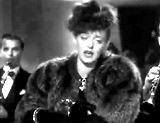
|
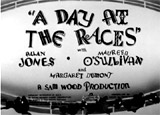
|
Toward the end of this Marx Brothers comedy, Pied-Piper-like Stuffy (Harpo Marx) led a cavalcade of children through a barn in Gabriel (pictured): ("Who Dat Man?"), a musical number that had little connection to the film's main plot. Next came the exuberant song and jitterbug-dance number through Negro shanty towns, titled All God's Chillun Got Rhythm (pictured), with the gravity-defying, jitter-bugging danced by Herbert "Whitey" White's Lindy Hoppers. |
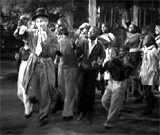 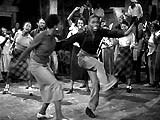
|
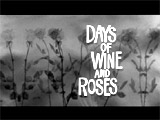
|
Director Blake Edwards' melodramatic film was an intense dramatic portrayal of an alcoholic, co-dependent couple:
Both turned to drink due to job and personal pressures, first as social drinkers and then as full-blown alcoholics. The screenplay was adapted from J.P. Miller's own 1958 Playhouse 90 television script. The film was honored with five Academy Award nominations, including Best Actor (Jack Lemmon), Best Actress (Lee Remick), Best Art Direction and Best Costume Design. Its sole win was Best Original Song for the title song Days of Wine and Roses (played under the opening credits) (pictured), with music by Henry Mancini and lyrics by Johnny Mercer.
|
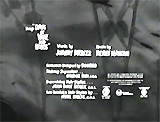
|
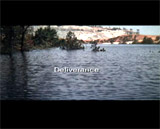
|
Before the film's major river adventure, its musical highlight was a lively, captivating banjo duel of bluegrass music titled Dueling Banjos (pictured) (actual title "Feudin' Banjos" - arranged and played by Eric Weissberg with guitarist Steve Mandell). [The song was authored by Arthur "Guitar Boogie" Smith in the 50s, and copyrighted by the Combine Music Corp.] Drew Ballinger (Ronny Cox) began by playing chords on his guitar. A deformed, retarded, albino hillbilly youngster (Billy Redden) (on banjo) appeared on the porch and answered him. The impromptu song was played as a rousing challenge between the two. Toward its furious ending, Drew admitted to the grinning boy: "I'm lost." When Drew, seen as a suspicious stranger, complimented the moon-faced winner when they were done - "God damn, you play a mean banjo," the mute, inbred, half-witted boy resumed his stony stare, turned his head sharply, and refused to shake hands with the interloping foreigner. Drew was obviously disappointed that the boy ignored him. |
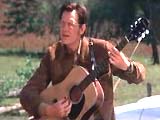 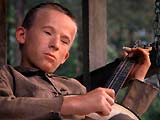
|
(alphabetical by film title) Introduction | A-1 | A-2 | B-1 | B-2 | B-3 | C-1 | C-2 | D-1 | D-2 | E | F-1 | F-2 | G-1 | G-2 H-1 | H-2 | I-J | K | L-1 | L-2 | M-1 | M-2 | N-O | P-1 | P-2 | R-1 | R-2 | S-1 | S-2 | S-3 | T | U-V | W | X-Z |